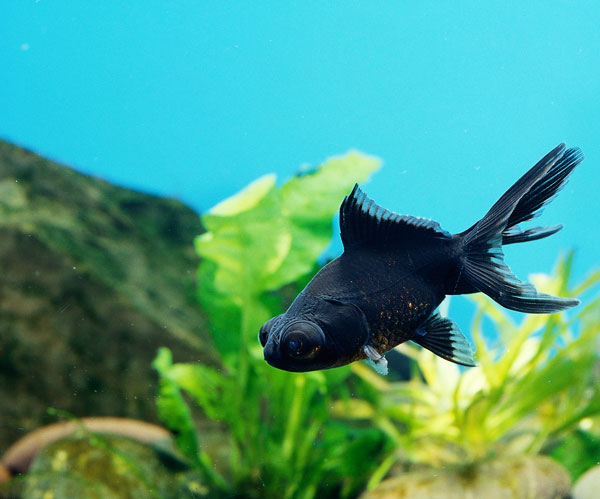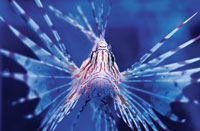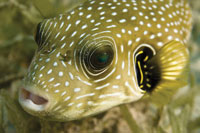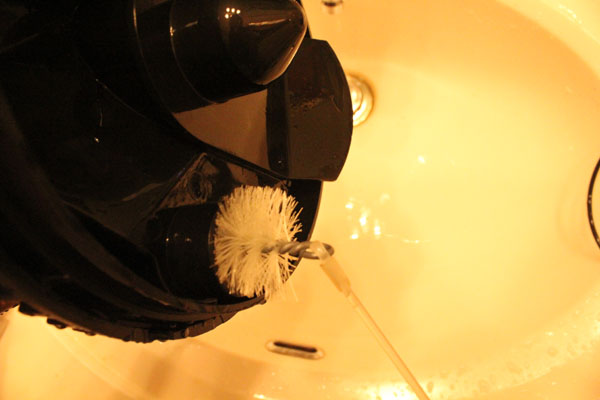
Q. I have a 20-gallon tank in my dorm room with a lot of plants, and my tank gets trashed when I try to net the fish. How are you supposed to catch them?
Gene Callaway
College Park, Maryland
A. Capturing fish in a well-planted tank takes planning, patience and cunning. Chasing them around the tank with a net will only result in damaged plants and terrified fish. Many fish are needlessly injured during the capturing process, leading to sickness and death. To avoid tearing up the plants and scaring the fish, I use different methods, depending upon the species and size of fish to be captured. Food is a tremendous motivator, and I use it to lure my fish in all but the most difficult cases. Seemingly slow, lumbering fish can turn into bolts of lightning when frightened, so the solution is to plan their capture during initial tank setup. I usually reserve one of the front corners of the tank for potted plants. By removing the potted plants, you have a clear capture area where it’s easy to see what you are doing while avoiding any interference with equipment. Refrain from feeding your fish for a day or two to ensure they are hungry and “motivated” to follow your lead. Fish are sensitive to their world being disturbed, so about 30 minutes prior to capture, gently remove the potted plants and place them into a bucket filled with water from the aquarium. In about half an hour, take a very small pinch of flake food and place your fingers into the water to wet the flakes. Press the dampened flakes against the glass in a corner just at the water’s surface. Net the fish from underneath while they are preoccupied eating. Be patient and avoid sudden moves until you are ready to “nab” them. Luring more fish might require additional pinches of food and patience.
This is effective at catching many of the docile, upper-level feeding species (e.g., mollies and guppies). Swift species (e.g., white clouds and zebra danios) usually require a more cunning approach. A homemade fish trap is a great way to capture these escape artists. I use three different traps, depending upon the species and the anticipated duration that the fish will be in the trap. For small fish that will remain trapped for only a few minutes, I use a large-mouthed, clear 16-ounce plastic water bottle with a half-inch hole drilled through the bottom of the container. Nothing lures fish better than a cube of juicy blood worms. Place the worms into the bottle’s cap, screw on the cap and flood the bottle through the half-inch hole. Position the bottle horizontally on the substrate, and wait for the fish to excitedly try to get at the food. One after another, they will enter the bottle through the half-inch hole and gorge themselves. When you capture the fish you were after, lift the bottle out of the tank with the drilled end facing up. Hold the bottle over a bucket, unscrew the cap and let the fish flow into the bucket. They could swim back out of the drilled hole but rarely do because nothing is luring them outside the bottle; and pouring water out will create a vacuum, resulting in panic, stress and a high probability of the fish ending up trapped inside the bottle without any water.
For elusive species like the kuhli loach, I use a similar bottle with a half-inch hole drilled into the end with two additional 3-by-1-inch rectangular slots cut into each side of the bottle. Aquarium sealant secures a plastic screen over the rectangular openings. Capturing loaches and other cagey fish sometimes takes hours, often overnight, and the screen allows water flow through the bottle eliminating the potential of trapped fish suffocating.
My third trap for larger fish is simply a square 1-quart water bottle with the bottom cut off. Shove the bait down into the cap area and lay the bottle horizontally on the substrate. Try to nestle the cap end of the bottle in a plant thicket with the open end facing outward into a nonplanted area. The fish will be preoccupied pecking the food from the space-constricted cap, while the plants will cloak your movements. Simply cover the open end with your hand or a net, and lift the bottle out of the tank.
The least desirable way (but often the only way to catch some fish, short of tearing up your tank) is to use a technique I learned while scuba diving at night. At night, diurnal fish often rest on the substrate and will not flee when illuminated. A scuba light is ideal for this method of capture because it is both waterproof and rubber-coated. The “rubberized” coating allows the light to be used anywhere in and around the tank without fear of bumping and cracking the tank’s glass. Always unplug and remove heaters so that they are not damaged by the dive light. Unless you have a jungle of plants, you can find the fish by shining the light through the aquarium’s glass. If not, remove the tank’s cover and submerge a couple of inches of the light just under the water’s surface to eliminate glare. Start in the nearest corner and slowly move the light in a serpentine pattern across the tank until you spot the fish. In large tanks, you will probably need to submerge the light and gently meander through the plants. Use a net, or simply siphon the sleepy fish out (this is a safe method, as long as you have a large enough hose so the fish don’t get stuck).
Gene, since your tank is well established, I recommend you use a simple fish trap. Good luck!
 Fish and Fungus
Black Moor Q. I have two large black moor goldfish, one larg
Fish and Fungus
Black Moor Q. I have two large black moor goldfish, one larg
 Invasive Aquatic Species
Last column, we discussed invasive species and the potentia
Invasive Aquatic Species
Last column, we discussed invasive species and the potentia
 Red Worms
Q. I’ve seen advertisements for red worms as a food for fish
Red Worms
Q. I’ve seen advertisements for red worms as a food for fish
 Pufferfish Teeth Care
Because their teeth are constantly growing, pufferfish
Pufferfish Teeth Care
Because their teeth are constantly growing, pufferfish
 How to Maintain Your Aquarium Filter
Aquarium filtration saw monumental advances in technology du
How to Maintain Your Aquarium Filter
Aquarium filtration saw monumental advances in technology du
Copyright © 2005-2016 Pet Information All Rights Reserved
Contact us: www162date@outlook.com